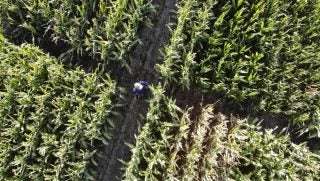It is that time of the year again — trailers bring in livestock animals, jeans pressed just right, and a little pep talk with your animal before you hit the show ring. However, with livestock shows starting back up again also brings up the need to refresh biosecurity measures.
As in-person poultry and livestock shows and events begin to resume, Dr. Charlie Broaddus, State Veterinarian with the Virginia Department of Agriculture and Consumer Services (VDACS), reminds livestock and poultry owners and show managers that there is the potential for animal disease spread when animals are commingled.
“Anytime animals are co-mingled at events, there is a risk they may be exposed to an infectious disease agent. Foot and Mouth Disease of livestock, Equine Herpesvirus Myeloencephalopathy of horses, Avian Influenza of poultry and Porcine Epidemic Diarrhea (PED) of pigs are all examples of diseases that can spread quickly,” said Broaddus. “Practicing and implementing sound biosecurity measures is critical in keeping the state’s animals disease-free and marketable. I encourage every person involved in showing livestock to enhance their biosecurity efforts.”
As an example, Equine Herpesvirus Myeloencephalopathy is another highly contagious disease that has caused severe neurologic signs and death at multiple equine events across the country recently. Avian Influenza is a highly contagious virus that can infect poultry, such as chickens, turkeys, pheasants, quail, domestic ducks, geese and guinea fowl. Highly Pathogenic or “high path” Avian Influenza is often fatal in chickens and turkeys.
Implementing sound biosecurity measures and advanced planning can reduce the chances of spreading an infectious disease by people, animals, shoes and clothing or equipment. Show managers should have a proper biosecurity plan ready to execute in the event that an animal disease is introduced at a major stock show or event. VDACS offers the following guidelines to help minimize risk at events where animals co-mingle. These general recommendations also apply to diseases that can be spread between humans and animals.
Biosecurity for animal exhibitors:
- Consult your veterinarian to establish an appropriate vaccination program for your livestock prior to attending an event.
- Before stalling your animal at an event, make sure the stall has been cleaned and disinfected and use clean, fresh bedding.
- Minimize direct contact with other animals.
- Use your own water and feed buckets. Avoid letting your animal(s) drink from a communal water trough. Fill water buckets from a faucet, not a shared tank.
- For equines, do not share grooming equipment or tack. If you must, then wash and disinfect it before returning to your own animal(s).
- Wash your hands thoroughly after handling other animals to minimize the risk of transferring a disease back to your animal.
- Before returning home from an event, clean and disinfect your equipment (boots, tack, grooming supplies, buckets, etc.) to help reduce the risk of transporting an infectious agent back home.
- Isolate your returning animal(s) for two weeks or prevent contact with your other animals and watch for signs of illness in all of your animals.
- When you come home from a fair/exhibition be sure to disinfect your trailer.
- Consult your veterinarian concerning these and other steps to follow to reduce the risk of your animal acquiring an infectious disease while traveling.
Biosecurity for event organizers:
- Minimize contact between animals where possible.
- Minimize spread by human hands (limit public access, provide hand sanitizer, establish restricted areas in front of stalls and trailers, and post hand-washing signs).
- Minimize spread by shared tack (post signs advising participants not to share equipment).
- Where practical, provide solid, high-walled stalls to minimize the spread of infectious nasal droplets.
- Use best practices when visiting an animal exhibit such as a fair or petting zoo:
- Locate hand-washing stations and use them often. Always wash your hands after petting animals or touching the animal enclosure, especially before eating and drinking.
- Use running water and soap whenever possible. Use hand sanitizer if running water and soap are not available.
- Keep food and drinks out of animal areas.
- Never allow children to put their hands or objects such as pacifiers in their mouths while interacting with animals.
“Implementing simple biosecurity measures to prevent disease spread and having an established plan of action to address disease outbreaks if they occur protects that experience for the public, exhibitors, event managers and animals alike,” said Broaddus.


